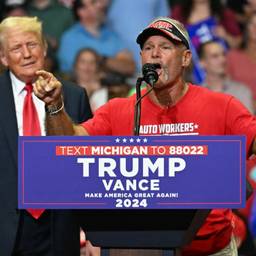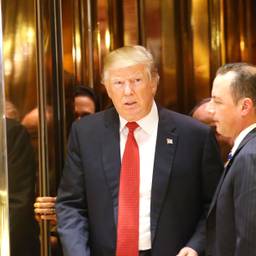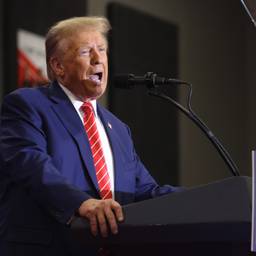Reagan Was a Disaster for the Labor Movement. A Second Trump Term Could Be Worse.
The Right has given us plenty of indications of the dangers a second Trump term could pose to labor. To see how bad things might get, we can look to another example of a brutally anti-labor presidency: Ronald Reagan’s.
Chris Bohner
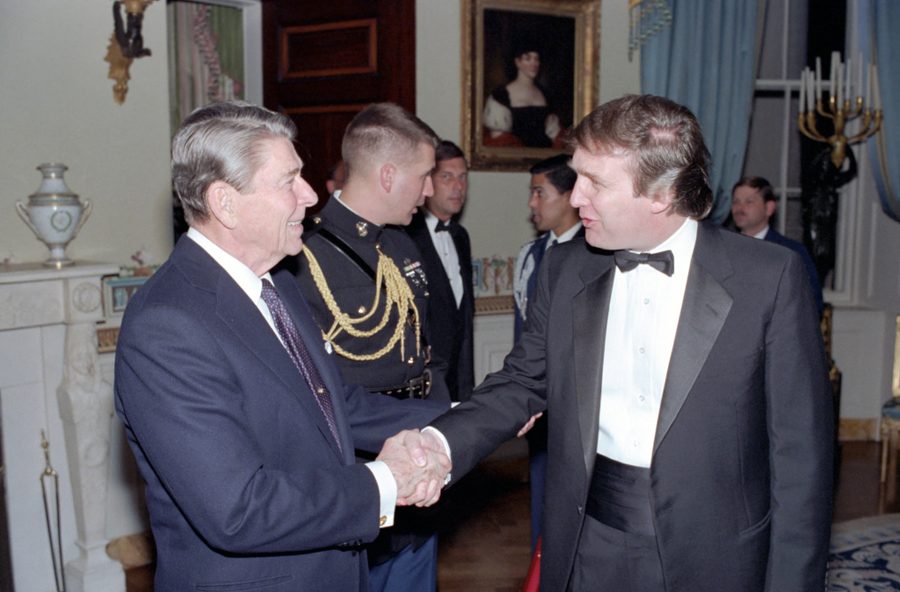
In the late 1990s, as AFL-CIO president John Sweeney led the federation’s ultimately failed program to boost union organizing, the phrase “organize or die” was standard rhetoric in labor leader speeches and commentary. Unions did not organize at scale, however, losing 1.9 million members since 2000, with union density (the percentage of all workers represented by unions) declining from 13.5 percent of the workforce to 10 percent in 2023.
Yet instead of dying a slow death, organized labor’s finances have actually flourished. Labor’s net assets (assets minus debt) grew from $11 billion in 2000 to $35 billion in 2023.
How did organized labor escape the “organize or die” theory of decline? Two key pillars have allowed unions to remain viable despite a steady decline in membership. But a second Donald Trump presidency could unravel both. For some sense of what that might look like, we can examine a previous right-wing administration that was a bloodbath for the labor movement: Ronald Reagan’s first term as president.
How labor has held on
How have unions managed to survive over the past two decades, and in financial terms even do very well, despite the continued decline in union density? First, many unions have forged a relatively stable accommodation with their large, unionized employers over the last 30 years. In exchange for “labor peace” and stability, unionized companies have provided modest wage and benefit increases, steady dues income, and incremental union growth through corporate expansion. Indeed, since 2000, the strike weapon has been virtually retired as a tactic in labor-management relations (with the occasional flare-up like the Red for Ed strikes in 2018 – 19, or the 2023 strike surge).
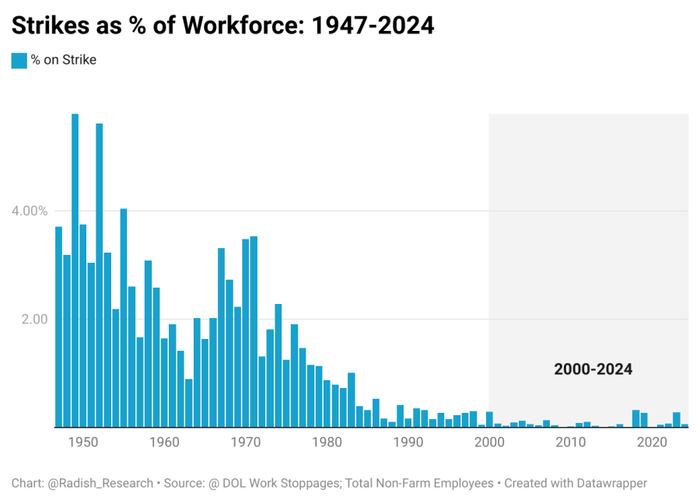
Second, labor has survived due to its junior partnership with the Democratic Party. In exchange for billions of dollars in campaign expenditures and political ground operations, the Democrats have supported a wide range of legislative and regulatory initiatives that buttress many unions’ modest organizing and collective bargaining goals.
But big structural changes that might fundamentally change the balance between capital and labor and help the labor movement stop its membership decline — most importantly labor law reform—have not been a top legislative priority for the Democratic Party, as it would engender unified opposition from employers. Nor have unions politically punished Democrats for their failure to pass labor law reform, because the party provides lower-level political support to individual unions or unionized sectors.
Another important political factor in labor’s survival has been the Democratic Party’s long-standing role in blocking legislation from the right that poses an existential threat to unions, like the federal right-to-work legislation routinely introduced in Congress by Republicans. Using divided government and the Senate filibuster at the federal level, labor and Democrats have maintained the status quo, preserving the fragile labor-management accommodation that has allowed labor’s balance sheet to grow even as it bleeds members.
However, the election of Donald Trump for a second presidential term could remove the political bulwarks that have kept organized labor viable. Unlike with the surprise 2016 election, Trump has had four years to prepare a government-in-waiting to rapidly enact a wide-ranging attack on the labor movement and the Left. If Republicans gain control of both houses of Congress, a toss-up at the moment, they could quickly implement their agenda (removing the filibuster at the first sign of resistance by Democrats).
The AFL-CIO and others have extensively documented the ambitious anti-labor agenda of the Heritage Foundation/Trump Presidential Transition Project. It ranges from rolling back every single labor reform under the Biden administration to outlawing public sector unions, rewriting a hundred years of labor law, and aggressively investigating and prosecuting labor leaders. Trump has distanced himself somewhat from Project 2025, though this doesn’t really suggest that he or a GOP-controlled Congress would be any more friendly to labor — look, for instance, at Trump’s recent remarks publicly encouraging the firing of striking workers. And even if just a fraction of the Right’s wish list is implemented, it could fundamentally challenge the viability of many unions.
What union collapse might look like
Were something like this to happen, it would not be the first time in recent memory a president launched an all-out assault on unions. Ronald Reagan’s administration was brutally anti-labor, and it accelerated the decline in union membership that had started in the 1950s. The first term of the Reagan administration can give us some sense of the potential impact of a Trump presidency on union membership, finances, and political power.
Reagan launched a broad attack on unions by breaking the Professional Air Traffic Controllers Organization (PATCO) strike, emboldening capital to attack unions through a series of devastating assaults at companies like Greyhound, Phelps Dodge, Massey, Caterpillar, Bridgestone/Firestone, and International Paper. The attack on labor was bolstered by a recession with high unemployment, which was explicitly engineered by the Federal Reserve to weaken the bargaining power of unions.
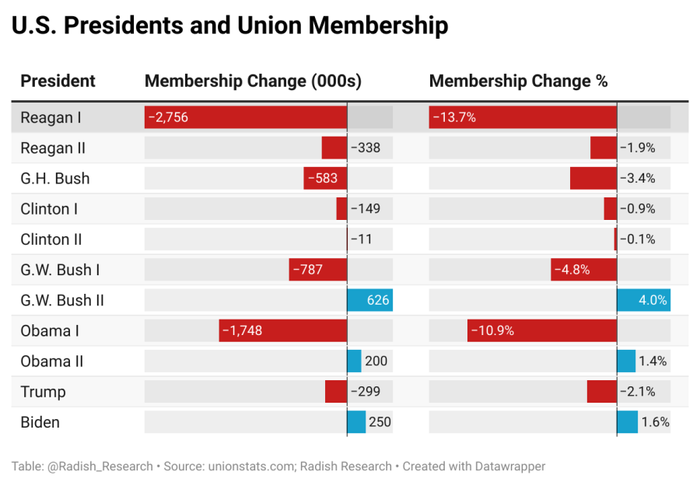
During Reagan’s first term, union membership declined by 2.8 million members or 14 percent, reducing union density from 23 percent in 1980 to 18.8 percent in 1984. If union membership shrunk at the same rate under a Trump presidency, organized labor would lose two million members, union density would decline from 10 percent today to 8.6 percent by the end of Trump’s term.
But there are reasons to think an anti-labor Trump term would be worse. With labor mostly fighting defensive fights and labor law eviscerated, it would be exceedingly difficult to organize new workers to keep up with employment increases, putting further downward pressure on union density. Like in the Reagan era, unionized employers would be emboldened to tear up the tenuous labor-management accord, challenging unions with concessions and decertifications.
If Trump were to outlaw public sector unions — a plank of Project 2025 — that would eliminate seven million (!) dues-paying members, on top of the sharp declines in unionized private sector workers. This nightmare scenario would effectively transport the labor movement back to the Gilded Age of the 19th century.
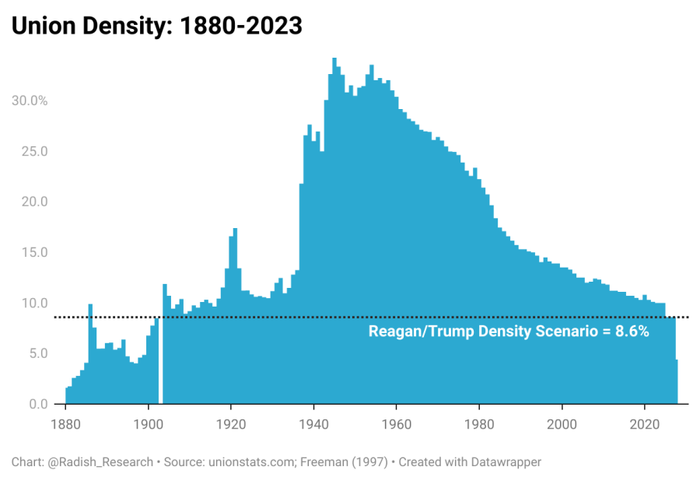
Putting aside the banning of public unions, a 14 percent reduction in union membership — the decline under Reagan’s first term — would significantly impact labor’s finances. While organized labor as a whole has $35 billion in net assets in reserves, a 14 percent reduction in revenues (tracking the membership decline) would lead to significant net losses, cannibalizing union treasuries.
Dramatic reductions in staff and strike funds could hamper labor’s power to fight back. A cursory financial analysis suggests that a 14 percent reduction in revenues would lead to a nearly $1 billion loss, as opposed to labor’s $1.7 billion surplus in 2022 (the latest financial data from the Department of Labor). To avoid deficits, labor would need to reduce staffing by approximately 8,300 workers. And revenue reductions of between 20 percent to 25 percent would require even more draconian layoffs or cuts to maintain a balanced budget. The financial impact would hit the more vulnerable unions disproportionately — particularly service and public sector unions — while the building trades and some manufacturing unions have larger financial reserves to help them absorb the blow.
With labor bleeding cash and fighting defensive wars with employers and the state, losing two million members would significantly reduce labor’s political power. Since 1980, the union household share of the electorate has declined from 25.7 percent to 15.8 percent in 2020, tracking the overall decline in union membership.
It is possible that a Trump administration would moderate its attack on labor, restrained by the high polling popularity of unions and his faux-populist courting of unionized workers. However, Reagan received the highest level of union support of any Republican presidential candidate since 1980, and it certainly did not have a moderating influence on his anti-labor assault.
The opportunity economy?
A Trump election has the potential to break organized labor as we know it. It’s no surprise, then, that Harris maintains relatively high support among union members. A Economist/YouGov poll in mid-September pegged union support at 57 percent for Harris, compared to 56 percent for Biden in 2020.
But broader working-class support for Harris lags Biden’s 2020 coalition. An aggregation of recent polls put Harris’s support with households earning less than $50,000 at 49 percent, compared to 55 percent for Biden in 2020. Similarly, Harris’s support from voters without a college degree was 42 percent, while in 2020, Biden received 48 percent support from non-college-educated voters.
One reason working-class voters may remain lukewarm about Harris is her embrace of a neoliberal rallying cry as a central tenet of her economic plan. Instead of addressing the structural causes of economic insecurity, the Harris campaign is inviting workers to participate in an “Opportunity Economy where everyone has a chance to compete and a chance to succeed.” A kindler and gentler economic Squid Game, where workers compete against each other in a figurative fight to the death, isn’t a compelling answer to the deep-seated economic anxieties of working-class voters.
Harris doubled down on this centrist approach with a speech laying out her economic agenda in Pittsburgh on September 25, in which “she paraphrased Warren Buffett, cited a survey of top economists and praised entrepreneurs in language that echoed Republican Senator Mitt Romney’s presidential run a dozen years earlier,” according to the New York Times. While there are some positive proposals in her platform, this is a campaign as focused on appealing to moderates and corporate donors as much as it is about appealing to union workers and the working class.
Neither of the labor movement’s choices this election are inspiring ones. And even with Biden’s relatively friendly National Labor Relations Board (NLRB), labor hasn’t managed to reverse its decades-long membership decline. Yet under a Harris administration, unions are at least likely to have continued breathing room; if Harris wins and Democrats also manage to gain control of Congress, they will even have a chance to pass labor law reform.
Unions will undoubtedly face a much more hostile environment under a Trump administration and a Republican Congress. If the GOP follows through on its anti-union threats, labor will be put on the defensive, forced either to accept draconian labor laws, or to resist by defying unjust laws at the cost of imprisonment and severe financial penalties
It is possible, of course, that unions will take up that fight and emerge victorious, as they did at times against employer and state repression in the early twentieth century. But the best shot for today’s small and largely quiescent labor movement to rebuild itself into an effective fighting force lies in avoiding the worst-case legal and legislative outcomes of a second Trump presidency.
This story was first published at Jacobin.
Disclosure: Views expressed are those of the writer. As a 501©3 nonprofit, In These Times does not support or oppose any candidate for public office
Chris Bohner is a union researcher and activist.
